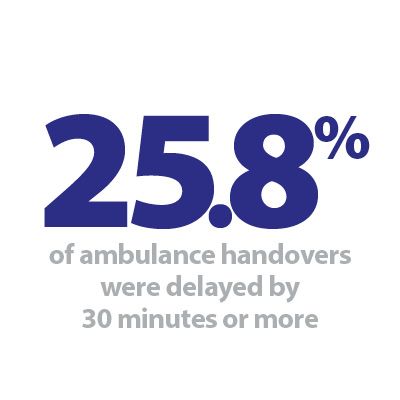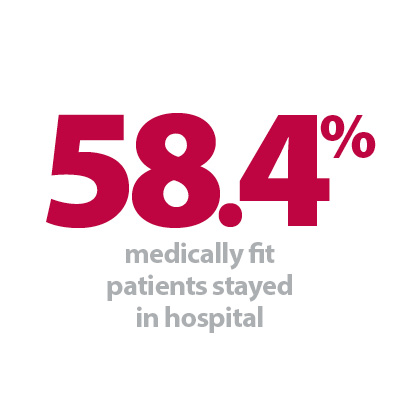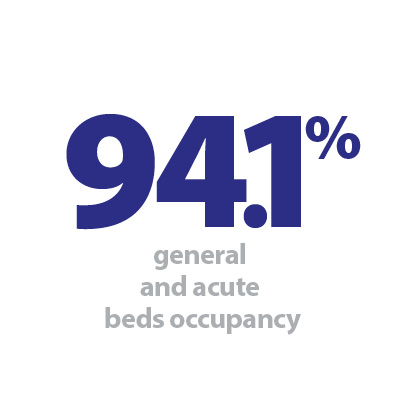


Introduction
Today the weekly winter situation reports by NHS England were published, providing an insight into the situation across emergency care and hospitals from 20 to 26 February.
This week's data continue to highlight the ongoing seasonal pressures. There were some positive improvements in the data, a testament to the efforts of staff and trust leaders, but conditions on the ground continue to be challenging.
Winter situation report (20-26 February)
A&E closures: There were no A&E closures again this week.
A&E diverts: There were a total of 29 A&E diverts this week, 25 more than the week prior.
Adult critical care: Adult critical care bed occupancy increased this week to 78.4%, up from 77.7%. This is also above levels seen in the same week last year (75.3%).
Ambulance arrivals: A total of 78,572 patients arrived by ambulance in the latest week. This is a decrease of 1.5% since last week and down by 7.5% compared to the same week last year.
Ambulance handovers: 25.8% of ambulance handovers were delayed by 30 minutes or more, slightly up from 25% last week. 11% were delayed by 60 minutes or more, also slightly up from 10.4% last week. A total of 20,247 hours were lost to ambulance handover delays.
Diarrhoea and vomiting: The number of beds closed due to diarrhoea and vomiting (D&V) and norovirus has decreased this week, with an average of 710 beds closed per day. This is down from 821 last week but remains higher than this time last year (220).
Discharges: There were an average of 23,586 patients each day who no longer met the criteria to reside, an increase of 344 patients from the week prior. However, compared to last week, a similar proportion of patients remained in hospital this week, with 58.4% (or 13,786) staying in hospital.
Flu: This week the average number of general and acute (G&A) beds occupied by flu patients each day decreased by 19% to 487. An average of 31 critical care beds were occupied by flu patients each day this week (11% fewer than the week before). Compared to the same week last year, the average number of G&A beds occupied by flu patients each day has increased by 1,326% (453 more). The average number of critical care beds occupied by flu patients has increased by 1,188% from the same time last year (29 more).
G&A beds: There was an average of 101,068 G&A beds open each day – 3.2% higher than the same time last year (3,174 more). On average each day, 266 beds were unavailable and void to non-COVID infections. Average bed occupancy remains high at 94.1%. This is an increase of 1.9 percentage points compared to the same week last year.
Long stay: The number of patients staying in hospital longer than 14 days dropped slightly this week (-0.5%). However, those staying longer than seven and 21 days increased by 0.3% and 0.4% respectively. Compared to the same time last year, the numbers of patients staying in hospital for longer than seven, 14 and 21 days have all increased (up by 8.9%, 11.0%, and 12.5% respectively).
Neonatal intensive care: Occupancy has risen this week to 66.1% compared to 65.1% last week, but down from 66.7% the same week a year before. The average number of care beds open is at 1,701, 0.5% more beds open compared to the same time last year.
Paediatric intensive care unit: Occupancy has risen this week to 83.0%, up from 80.1% last week. This remains higher than the same week last year (70.5%). The average number of care beds open this week has fallen by six beds to 357.
Respiratory syncytial virus (RSV): An average of 8 paediatric beds were closed this week due to RSV symptoms, down from 16 last week but slightly up from 6 last year.
Staff absences: There were an average of 48,497 total absences each day this week, of which 11% were COVID-19 related (5,300). The total number of staff absences increased slightly from the week before (48,497) but the proportion of COVID-19 related absences was slightly greater (up from 10%).
Our view
In addition to the winter sit rep data published today, NHS Digital also published the latest vacancy statistics for the end of December 2022. Despite a reduction from the quarter before, there are still 124,000 vacancies across the NHS. Any assessment of seasonal pressures must be considered within the context of widespread workforce shortages across systems.
The improvements in this week's data, for example the reductions in the number of beds occupied by D&V, norovirus and flu patients, give us some reason for hope, but this is in the context of wider pressures.
This week, ambulance handover delays have risen again, with nearly 26% of handovers being delayed by half an hour or more. We are also still seeing bed flow issues, which have been a major challenge for the NHS this winter. This week, all bed occupancy rates have risen, even though they were already concerningly high.
And while spring is just around the corner, trusts across the country will likely continue to experience these challenges for weeks to come.